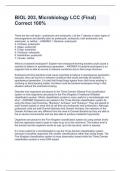Exam (elaborations)
BIOL 203, Microbiology LCC (Final) Correct 100%
- Course
- Institution
There are two cell types - prokaryotic and eukaryotic. List the 7 classes or basic types of microorganisms and identify each as prokaryotic, eukaryotic, both prokaryotic and eukaryotic, or neither. - ANSWER 1. Bacteria- prokaryotic 2. Archaea- prokaryotic 3. Algae- eukaryotic 4. Fungi- eukaryoti...
[Show more]



